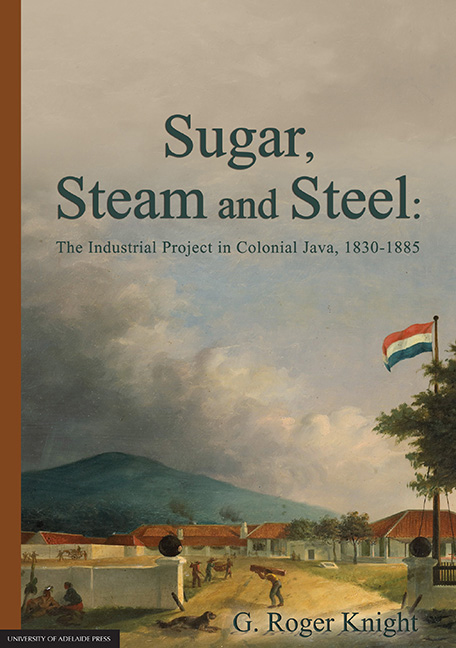Book contents
- Frontmatter
- Contents
- Abbreviations and Glossary
- Acknowledgements
- Introduction: Java Sugar, an Industrial Project and the ‘Oriental Cuba’, 1830-85
- Part I The ‘Industrial Revolution’ in Sugar Manufacture
- 1 Java's Singular Trajectory: Steam, Steel and the Industrial Project in Sugar
- 2 A Creole Prometheus: Steam, Paddle Boats and Sugar Factories
- 3 The Industrial Sugar Factory: Wonopringgo, Thomas Edwards and the Nederlandsche Handel-Maatschappij (NHM)
- Part II The ‘Peasant’ Economy, the Money Trail and the Bourgeoisie
- Part III Metamorphosis
- Conclusion: The Future of an Industrial Project: The 1880s and Beyond
- Archival Sources
- Bibliography
1 - Java's Singular Trajectory: Steam, Steel and the Industrial Project in Sugar
from Part I - The ‘Industrial Revolution’ in Sugar Manufacture
Published online by Cambridge University Press: 24 October 2017
- Frontmatter
- Contents
- Abbreviations and Glossary
- Acknowledgements
- Introduction: Java Sugar, an Industrial Project and the ‘Oriental Cuba’, 1830-85
- Part I The ‘Industrial Revolution’ in Sugar Manufacture
- 1 Java's Singular Trajectory: Steam, Steel and the Industrial Project in Sugar
- 2 A Creole Prometheus: Steam, Paddle Boats and Sugar Factories
- 3 The Industrial Sugar Factory: Wonopringgo, Thomas Edwards and the Nederlandsche Handel-Maatschappij (NHM)
- Part II The ‘Peasant’ Economy, the Money Trail and the Bourgeoisie
- Part III Metamorphosis
- Conclusion: The Future of an Industrial Project: The 1880s and Beyond
- Archival Sources
- Bibliography
Summary
During the course of the ‘long’ nineteenth century, sugar reinvented itself as an industrially manufactured product. Together with the applied sciences that sustained them, steam and steel — beginning, initially, as iron — characterised a sugar 'revolution’ that took place globally during a period that began around 1780 and reached its apogee circa 1914.
The term ‘revolution’ seems appropriate even though the time span was lengthy. Much has been written about this revolution in the context of cane sugar in the Caribbean and the New World in general (the production areas, that is to say, which since the sixteenth century had supplied the commodity to the Atlantic Zone and its hinterland). Nonetheless, the revolution also had a significant impact throughout Asia and the Indian Ocean, in areas as diverse as Mauritius, the Indian subcontinent and South-East Asia (and in the neighbouring north-east of Australia).
In Dutch controlled Java, however, the impact was particularly pronounced and sustained. There, a singular industrial project — singular in respect to its combination of scale, output and technological-scientific advance — took shape during the middle decades of the nineteenth century and reached a precocious florescence toward the century's end. Indeed, by the 1880s the developed state of manufacturing on Java placed the island well ahead of any of its erstwhile counterparts elsewhere in Asia or its Indian Ocean counterparts and roughly on par with the most advanced sugar industries of the New World. The Dutch colony had become, in effect, the ‘Oriental Cuba’, with an exported output of cane sugar that was only exceeded by that of its Caribbean antipode.
Sugar's Reinvention as an Industrially Manufactured Commodity
Until the nineteenth century, the commodity we know as ‘sugar’ was derived exclusively from the sugar cane, which in turn was selectively bred from grasses found, it seems most likely, on the south-eastern fringes of Asia, possibly New Guinea.1 The use of cane to make sugar appears to have originated in various regions of Asia in premodern times, and to have been transmitted from there to the Middle East, then into the Mediterranean and eventually from there into the New World.
For centuries, sugar was manufactured worldwide by artisans using essentially handicraft techniques. In some places, it still is. Though these techniques varied considerably from place to place as well as over time, there were some essential similarities.
- Type
- Chapter
- Information
- Sugar, Steam and SteelThe Industrial Project in Colonial Java, 1830-1885, pp. 11 - 32Publisher: The University of Adelaide PressPrint publication year: 2015

